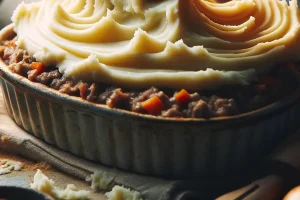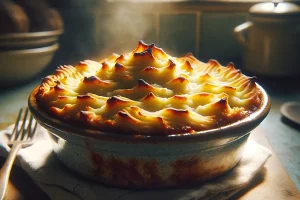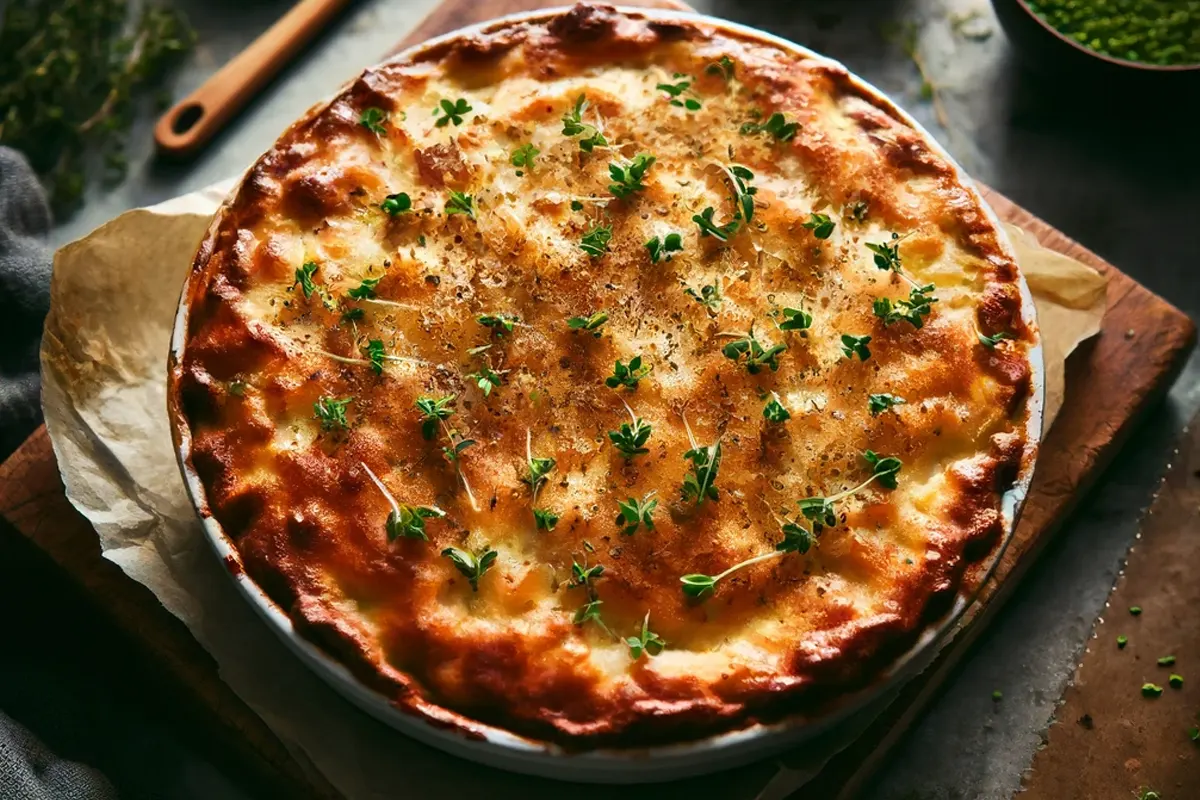Diving into the world of culinary classics, there’s a hearty dish that stands out for its comforting embrace and rich heritage: Shepherd’s Pie. A beacon of home-cooked meals, this dish is a symphony of savory meat, tender vegetables, and a golden crust of mashed potatoes. It’s a recipe that tells stories of tradition, innovation, and the simple joy of gathering around a meal. In this comprehensive exploration, we’ll uncover the layers of Shepherd’s Pie, from its rustic origins to the multitude of variations that grace our tables today. Prepare to embark on a flavorful journey that promises not just a recipe, but a piece of culinary history brought to life on your plate.
Understanding Shepherd’s Pie: A Culinary Classic
The Historical Roots of Shepherd’s Pie
Once upon a time, in the rolling hills of the British Isles, a dish was born out of necessity and thrift. Shepherd’s Pie, a name that conjures images of pastoral landscapes and hearty fare, began its journey in the cottages of sheepherders. Originally devised to use leftover roasted meat, this dish was a practical solution to avoid waste, transforming yesterday’s dinner into today’s comfort food sensation. The early versions of Shepherd’s Pie were humble, with minced lamb or mutton beneath a simple crust of mashed potatoes, embodying the essence of resourcefulness and warmth.
Transitioning through time, the pie evolved, adopting new ingredients and techniques, yet its soul remained tied to the shepherd’s fields. It’s a testament to the dish’s adaptability and enduring appeal, making it a beloved classic across generations.
Shepherd’s Pie Today: Variations and Popularity
Fast forward to today, and Shepherd’s Pie stands tall as a culinary chameleon, with each rendition reflecting the unique flair of its creator. From the traditional lamb-based pie, aptly named in honor of the shepherds, to its beef counterpart known as Cottage Pie, the essence of the dish lies in its layered structure and comforting depth of flavors.
But here’s a burning question: How do you keep Shepherd’s Pie from falling apart? The secret lies in the viscosity of the filling—rich and thick enough to support the weight of the fluffy potato crown. It’s this delicate balance that transforms good shepherd’s pie into a great one, ensuring each slice holds its shape with pride.
As Shepherd’s Pie continues to reinvent itself, from gluten-free renditions to vegetarian delights, its spirit remains rooted in the joy of sharing a hearty meal. It’s a dish that transcends boundaries, inviting everyone to partake in its savory embrace, regardless of dietary preferences.
In the end, the story of Shepherd’s Pie is a narrative of transformation and tradition, a dish that has wandered from the fields of yore to the global dinner tables of today, yet has never forgotten its simple, soulful beginnings. Stay tuned as we delve deeper into the art of crafting the perfect Shepherd’s Pie, exploring the ingredients that make it a timeless treasure in the world of comfort food.

Crafting the Perfect Shepherd’s Pie: Ingredients Guide
Essential Ingredients for Traditional Shepherd’s Pie
At the heart of a traditional Shepherd’s Pie, simplicity and quality reign supreme. The foundation lies in choosing the right meat—lamb, as tradition dictates, minced or ground, provides a rich, unmistakable flavor characteristic of this iconic dish. To complement the meat, a medley of vegetables is essential; carrots, peas, and onions meld together, creating a harmony of flavors that underline the pie’s rustic origins.
The crowning glory of Shepherd’s Pie is, of course, the mashed potato topping. Creamy, buttery, and lightly seasoned, it’s not just a lid but a statement, browning to perfection under the broiler to create that irresistible golden crust. Achieving the right consistency with your potatoes—fluffy yet firm—is crucial to prevent your pie from becoming a soggy affair.
Creative Substitutions for Dietary Preferences
Embracing the diverse tapestry of dietary needs and preferences, Shepherd’s Pie lends itself beautifully to customization. For those seeking a lighter version, swapping lamb for lean ground turkey or chicken can cut down on the fat without compromising the dish’s comforting essence.
Vegetarians and vegans, fear not, for the spirit of Shepherd’s Pie can be captured without meat. Instead, lentils, finely chopped mushrooms, or a mix of hearty beans can serve as excellent substitutes, providing texture and depth that rival the traditional lamb filling. Moreover, pair these with a rich, umami-laden gravy, and you’ve got a vegetarian or vegan Shepherd’s Pie that stands tall amongst its meat-based counterparts.
In the realm of the potato topping, creativity knows no bounds. Additionally, for those avoiding dairy, olive oil or a dairy-free butter substitute can be used to achieve that creamy texture. Moreover, for a twist, why not try a sweet potato topping? Its natural sweetness offers a delightful contrast to the savory filling below, adding a layer of complexity to the dish.
As Shepherd’s Pie continues its journey across kitchens worldwide, it’s clear that this dish is more than a recipe; it’s a canvas for culinary expression. Whether sticking to tradition or venturing into the realm of substitutions, the key lies in balancing flavors and textures, ensuring every bite is a testament to the dish’s rich heritage and versatility.
Mastering Shepherd’s Pie: A Step-by-Step Guide
Preparing the Meat Filling
The soul of Shepherd’s Pie lies in its hearty, flavorful filling. Begin by gently sautéing finely chopped onions and carrots in a bit of oil until they’re soft and golden. This is where the magic starts – these veggies lay the groundwork for a rich tapestry of flavors.
Next, introduce the ground lamb to the pan, breaking it apart and browning it until it’s no longer pink. It’s essential to ensure the lamb is thoroughly cooked, as this not only ensures safety but also deepens the filling’s flavor profile. At this juncture, a sprinkle of flour over the meat can work wonders, acting as a thickener for the gravy that’s to follow.
Ah, the gravy – a pivotal component that binds the filling together. Furthermore, a splash of rich broth and a dash of Worcestershire sauce, combined with the flour-coated meat and vegetables, will create a thick, savory sauce. Additionally, let this simmer gently, allowing the flavors to meld together beautifully. Moreover, remember, the consistency here is key; you’re aiming for a thick, rich mixture that can support the potato topping without turning into a soggy mess.
Crafting the Perfect Potato Topping
While your filling simmers, turn your attention to the potatoes. Choose a starchy variety for the best results – they yield a fluffier, creamier mash. Boil the potatoes until tender, then drain and return them to the pot. The next steps are crucial for achieving that silky-smooth texture: a generous addition of butter, a splash of milk, and a robust mashing session. Season with salt and pepper to taste, and consider a hint of garlic or herbs for an extra flavor dimension.
The trick to a great topping is in the consistency – too dry, and it won’t spread; too wet, and it may sink into the filling. Aim for a creamy, spreadable consistency that holds its shape.
Assembling and Baking Tips
With both components ready, it’s time to bring it all together. Spoon the meat filling into a baking dish, creating an even layer that’s begging to be topped. Then, gently layer on the mashed potatoes, starting from the edges and working your way in. A fork can be used to create peaks on the surface, which will crisp up beautifully in the oven.
The bake is the final act in this culinary symphony. A hot oven will ensure the topping gets that desirable golden hue, while the filling bubbles away underneath. Keep an eye on it, as the last thing you want is to burn those meticulously crafted potato peaks.
Remember, patience is a virtue when it comes to Shepherd’s Pie. Letting it rest for a few minutes before serving can make all the difference, allowing the filling to set slightly and making it easier to serve neat, hearty portions.
Mastering Shepherd’s Pie is about embracing each step of the process, from the initial sauté to the final bake. It’s a dish that rewards care and attention to detail, resulting in a comforting classic that’s sure to warm hearts and bellies alike.

Serving Shepherd’s Pie: Tips and Pairings
Ideal Side Dishes for Shepherd’s Pie
Shepherd’s Pie is a hearty, all-encompassing meal, with its savory meat filling and comforting potato topping. However, the addition of a side dish or two can elevate this classic comfort food into a well-rounded feast. A simple, crisp green salad can provide a refreshing contrast to the richness of the pie, with a tangy vinaigrette cutting through the dish’s savory depths. For something a bit heartier, consider roasted root vegetables, their natural sweetness and earthy flavors complementing the pie’s robustness. Steamed green beans, lightly seasoned, can also add a splash of color and a crunchy texture to the meal, creating a delightful balance on the plate.
Beverage Pairings
When it comes to quenching your thirst, a variety of beverages can harmonize with the flavors of Shepherd’s Pie. A sparkling water with a twist of lemon or lime can cleanse the palate between bites, offering a refreshing counterpoint to the dish’s richness. For those preferring something sweeter, a crisp apple cider, non-alcoholic, can complement the savory notes of the pie with its fruity undertones. Herbal teas, such as peppermint or chamomile, can also be a soothing accompaniment, aiding digestion and enhancing the overall dining experience.
The art of serving Shepherd’s Pie extends beyond the dish itself, encompassing the sides and drinks that accompany it. By carefully selecting accompaniments that contrast and complement the pie’s flavors and textures, you can craft a meal that’s both satisfying and balanced. Remember, the key is in the harmony of flavors, ensuring that each element on the plate has its moment to shine, contributing to a memorable dining experience.
Elevating Your Shepherd’s Pie: Advanced Techniques
Infusing Flavors into Shepherd’s Pie
To elevate your Shepherd’s Pie to new culinary heights, consider delving into the realm of flavor infusion, incorporating sustainable and nutritious ingredients as advocated by FAO’s guidelines on food security and nutrition (FAO). One sophisticated technique is to layer in herbs and spices that complement the lamb’s rich profile. Think rosemary, thyme, or a hint of mint—each can add a new dimension to the meat filling. Incorporating a splash of red wine or a robust stock into the gravy can also deepen the flavors, creating a more complex and nuanced filling.
Another method to infuse flavor is through the caramelization of onions and carrots before adding them to the meat. This process enhances their natural sweetness, providing a subtle counterbalance to the savory lamb. Similarly, roasting garlic before mashing it into the potatoes can add a mellow, aromatic quality to the topping that’s simply irresistible.
Achieving the Perfect Crust and Texture
The crust of your Shepherd’s Pie is not just a topping; rather, it’s a statement. Achieving that perfect, golden-brown crust requires a careful balance of ingredients and technique. Additionally, one advanced method is to incorporate egg yolks into your mashed potatoes. Not only do the yolks add richness, but they also help the topping brown more beautifully in the oven. Moreover, for an extra crispy finish, a light sprinkling of grated Parmesan cheese or breadcrumbs over the top can add a delightful crunch.
Texture plays a crucial role in the overall enjoyment of the pie. Consider varying the texture of the mashed potatoes by leaving some chunks slightly larger for a more rustic feel. Alternatively, for a smoother, more refined topping, pass the potatoes through a ricer or food mill to achieve an ultra-creamy consistency.
When it comes to the filling, achieving the right viscosity is crucial. It should be thick enough to hold its shape when cut, but not so dense that it feels heavy. A roux-based gravy, adjusted to the perfect consistency, can ensure your filling is luscious and velvety, binding all the components together harmoniously.
Employing these advanced techniques in your Shepherd’s Pie preparation can transform a familiar dish into an extraordinary culinary experience. Furthermore, it’s about embracing the nuances of flavor and texture, allowing each element to shine and contribute to the dish’s symphony of tastes. Additionally, remember, the beauty of Shepherd’s Pie lies in its versatility and the opportunity it presents for creative expression in the kitchen.

Shepherd’s Pie FAQs: Expert Answers to Common Questions
Can Shepherd’s Pie Be Made Vegetarian?
Absolutely! Transforming Shepherd’s Pie into a vegetarian delight is not only possible but also incredibly satisfying. Swap the traditional lamb filling for a rich mix of lentils, mushrooms, and beans. These ingredients mimic the texture and heartiness of meat, ensuring the dish retains its comforting essence. Enhance the filling with umami-rich elements like tomato paste and soy sauce to deepen the flavors, making the vegetarian version just as savory and fulfilling.
How to Store and Reheat Leftovers
Shepherd’s Pie is one of those wonderful dishes that can taste even better the next day. To store leftovers, first, let the pie cool to room temperature to prevent condensation inside the container, which could make the topping soggy. Cover it tightly with foil or transfer it to an airtight container and refrigerate for up to 3-4 days. When you’re ready to reheat, cover the pie with foil and warm it in a preheated oven at a moderate temperature until heated through. This method helps retain moisture, ensuring the pie remains deliciously tender and flavorful.
Common Mistakes and How to Avoid Them
One of the most common pitfalls when making Shepherd’s Pie is a runny filling, which can cause the potato topping to sink and the layers to merge. Prevent this by ensuring your gravy is sufficiently thickened before assembling the pie. Another mistake is under-seasoning, which can leave the dish tasting bland. Be generous with herbs and spices, and always taste and adjust the seasoning at each stage of cooking.
A question that often arises is, “How do you keep Shepherd’s Pie from falling apart?” Firstly, the key lies in the filling’s consistency, which should be thick and hearty. Secondly, allowing the pie to rest for a few minutes after baking is crucial. This brief resting period helps the filling set slightly, thereby making it easier to serve neat slices that hold their shape.
Navigating the common pitfalls of Shepherd’s Pie preparation can enhance your cooking experience, ensuring the end result is as delightful in taste as it is in presentation. With these expert tips in mind, you’re well-equipped to create a Shepherd’s Pie that’s not only a feast for the taste buds but also a testament to your culinary prowess.
Conclusion: The Timeless Appeal of Shepherd’s Pie
Recap of Key Points
Embarking on the culinary journey of Shepherd’s Pie, we’ve explored its rustic origins, witnessed the evolution of ingredients and variations, and delved into the artistry of perfecting this classic dish. From the foundational meat and vegetable filling to the creamy potato topping, each component plays a crucial role in crafting a pie that’s both comforting and satisfying. We’ve also embraced the versatility of Shepherd’s Pie, adapting it to meet a range of dietary preferences without compromising its hearty essence.
Encouragement to Experiment with Recipes
The beauty of Shepherd’s Pie lies in its simplicity and adaptability. It’s a canvas for culinary creativity, inviting you to experiment with flavors, textures, and ingredients. Whether you’re sticking to the traditional lamb filling or exploring vegetarian alternatives, the opportunity to put your own spin on this classic dish is boundless. Don’t be afraid to incorporate seasonal vegetables, play with different herbs and spices, or try new techniques to enhance the crust and filling. Each variation you create adds a new chapter to the rich history of Shepherd’s Pie.
A question that often arises is, “How do you keep Shepherd’s Pie from falling apart?” Well, the key lies in the filling’s consistency, which should be thick and hearty. Additionally, allowing the pie to rest for a few minutes after baking is crucial. This brief resting period helps the filling set slightly, consequently making it easier to serve neat slices that hold their shape.

